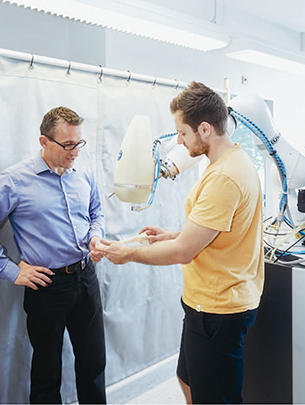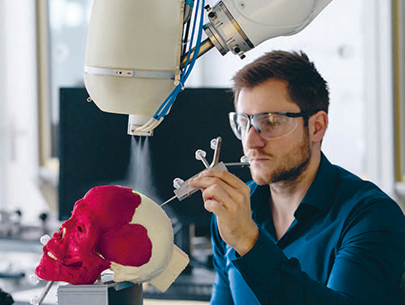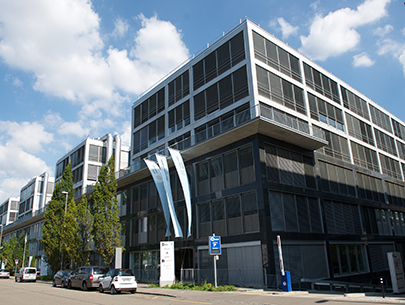Finding new solutions in medicine with the art of engineering
Martin Hicklin
The latest department to be established at the University of Basel is the first of its kind in the canton of Basel-Landschaft: In Allschwil, directly adjacent to the Swiss Innovation Park in Northwestern Switzerland, 60 researchers are creating innovative solutions to medical problems.
Laid diagonally across the round table in the new Department of Biomedical Engineering (DBE) in Allschwil is an intricate model of a spine. Yellow stumps of nerves protrude from the spaces between the interconnected vertebrae. A delicate construction upon which so much depends, yet which can so easily be damaged – especially when a thick orthopedic screw has to be inserted for stabilization. The screw must be positioned at the right angle, at the right depth, and without damaging any of the fragile structures.
Philippe Cattin uses the model to demonstrate how this is achieved: He turns it around, and applies a tool with a screw holder and a cross handle. At the base of its shaft is a small box containing a gyroscope, a compass, and an accelerometer. These tools facilitate the exact positioning of a screw using simple methods and without X-rays. “With this device, we can give the surgeon a tool that enables him or her to navigate precisely, and which costs a fraction of what is usually spent on a guidance system. What’s more, we spare the patient from radiation,” Philippe Cattin says happily.
The Professor of Medical Image Analysis is the first head of the university’s new Department of Biomedical Engineering. Everything they design is inexpensive thanks to the mass-produced but highly sophisticated components taken from the smartphone industry.
The “NaviPen” is a typical product of the DBE: “Our goal is to assist medical professionals using the art of engineering,” says the 48-year-old. They use simple methods where possible – which is how a CHF 300 Android tablet was converted into a navigation instrument to be used during operations.
When he was 40, Philippe Cattin was appointed to his role as Professor of Medical Image Analysis at the University of Basel, a position that was sponsored by Swiss entrepreneur and businessman Hans-Jörg Wyss. As soon as he arrived in 2007, Cattin founded a Medical Image Analysis Center, which he continues to oversee, and which then became part of the new DBE along with a number of other departments and research groups (see box).
Cattin is highly qualified for his job: He completed his PhD in robotics at the ETH, and then continued his research in electrical technology and in the computer vision laboratory. “This was the perfect preparation for my current job,” says Cattin.
Indeed, his trajectory has been exemplary. After an apprenticeship as a lab assistant at the ABB in Baden, he found his way to the ETH Zürich – and excelled. From his apprenticeship and his Bachelor’s, all the way through to his Master’s at the ETH, he continued to win top accolades at every stage. He is still benefiting from his training and manual skills: “I’m happy to make a part we need every now and then.”
In the various different projects, Cattin’s team looks for ways of supporting therapies that require simultaneous imaging, and for ways of enabling better spatial orientation. Using models, they attempt to facilitate more precise interventions on organs that move as a result of breathing, and to reduce the collateral damage caused by radiation. They also have several ongoing collaborative projects with partners at hospitals. These involve sophisticated imaging methods for the spinal cord, for example, or address the problem of children’s lungs or damaged nerve cells.
This has resulted in close cooperation with the medical imaging analysis group, which has an international reputation for evaluating multiple sclerosis images using high-precision tools under the umbrella of the university hospital’s own MIAC Corporation. This group is involved in numerous clinical trials of MS treatments.
A powerful partner and early proponent of the DBE is the oral surgeon Hans-Florian Zeilhofer. After arriving from Munich, he began experimenting with techniques for better orientation during interventions, and he promoted projects aimed at solving surgical problems. In 2004, Zeilhofer founded a pioneering high-tech research center (HFZ) at the university hospital, building on his good connections in the medtech sector. Researchers at the HFZ worked on the development of robots, and attempted to use lasers as precision cutting instruments for bones.
One robot called CARLO (computer assisted robotguided laser osteotome), which can cut precise bone fragments to plan, is currently being developed for the market by the spin-off company AOT. Cattin and Zeilhofer are co-founders, together with laser physicist Alfredo Bruno and surgeon Philipp Jürgens. The robot-controlled laser bone-cutting system will now be “miniaturized” in the so-called “MIRACLE” research project, so that it can be used for minimally invasive “buttonhole” surgeries. This project – which is also led by Philippe Cattin and Hans-Florian Zeilhofer – has attracted funding of CHF 15.2 million over fi ve years from the Werner Siemens Foundation. The project will also investigate how to rectify bone defects using metal structures manufactured by 3D printers.
With these developments in Allschwil, earlier initiatives are beginning to bear fruit. The Department of Biomedical Engineering can trace its origins to a shift of focus onto clinical morphology and biomedical engineering at the Faculty of Medicine in 2005. This was one year after Zeilhofer founded the HFZ. Following this, the medtech entrepreneur Hans-Jörg Wyss (then Synthes) and Thomas Straumann each funded a professorship.
Working on image analysis, Cattin took the position of Wyss Professor, and Bert Müller became Straumann Chair of Materials Science and established the Biomaterials Science Center. Both are now members of the DBE. In 2014, the university management board decided to create the Department of Biomedical Engineering, and thereby placed a focus on medical technology with the potential for industrial spin-offs.
The Swiss Innovation Park in Northwestern Switzerland in Allschwil is a logical site to establish the department. The new laboratories are located right next to Actelion’s creatively arranged company headquarters. Over 60 people will initially work here in research and development in the new infrastructure extending over 3,000 square meters. Additional professorships are being generated, and there are already three spin-off companies. These impressive beginnings will undoubtedly be seen as the start of great success in the history of the region.
Philippe Cattin studied Computer Sciences at the University of Applied Sciences in Brugg/Windisch. He gained his Master’s at ETH Zurich, where he completed a doctorate at the Institute for Robotics in 2002. In 2007, he founded the Medical Image Analysis Center at the Faculty of Medicine, University of Basel. Since 2014, he has been head of the newly created Department of Biomedical Engineering.
The Department of Biomedical Engineering is composed of the following institutes and research groups: Biomaterials Science Center, Biomechanics, Clinic of Radiology and Nuclear Medicine, Institute of Forensic Medicine, Medical Image Analysis Center, Medical Laser Physics, Medical Robotics, Musculoskeletal Research, Oral Health Technologies, Pneumology Research Group, Quantitative Biomedical Imaging, Radiological Physics and Tissue Engineering Technologies. The Department also works in close cooperation with Basel University Hospital and the University Children’s Hospital.



